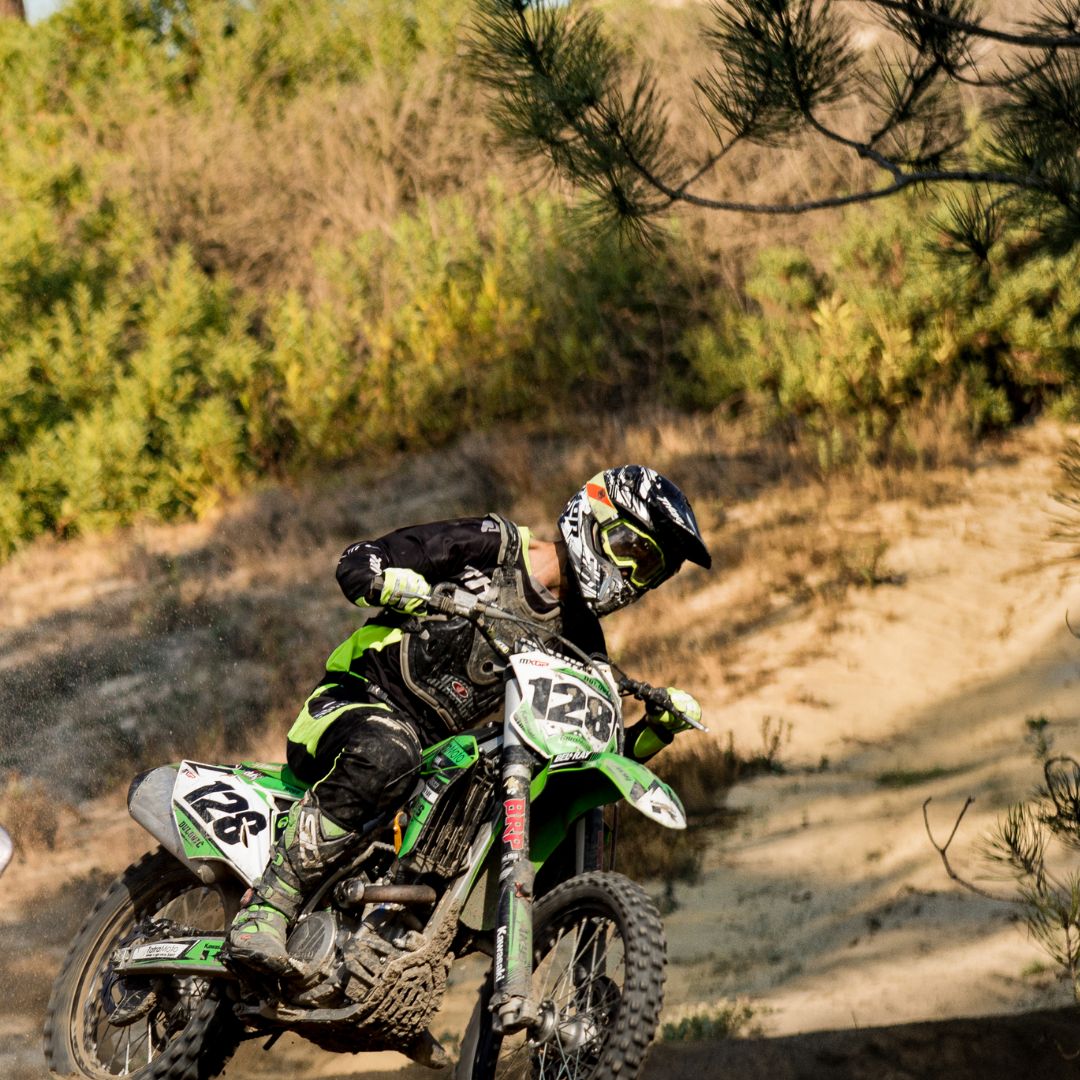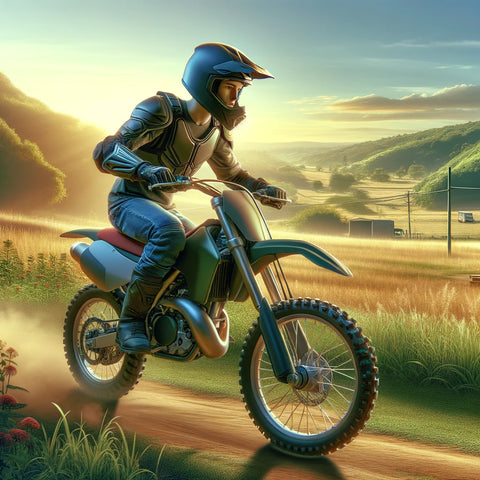Published: 19.02.24
Updated: 27.05.25

Why do some dirt bike riders navigate rough terrains with ease? The secret lies in mastering body positioning.
Whether teaching kids or refining your own skills, proper body positioning enhances safety, control, and performance. Here are 10 essential tips for every dirt bike rider.
1. Why Body Positioning Matters
Body positioning isn’t just about style—it’s critical for safer, smoother, and more thrilling rides. It improves control and reduces injury risk on challenging trails.
- Safety: Proper posture minimises falls by enhancing bike control.
- Performance: Balanced positioning improves handling and efficiency.
-
Key Tips:
- Keep your head up, eyes forward.
- Maintain a straight back to reduce fatigue.
- Relax shoulders for flexibility and comfort.
2. Perfecting Your Riding Stance
- Standing Tall: Stand on footpegs with knees slightly bent to absorb shocks on rough terrain.
- Balance: A proper stance stabilises the bike, aiding navigation.
-
Practice Tips:
- Stand on pegs while stationary to find balance.
- Ride slowly in a safe area, focusing on stance.
3. Foot Placement for Control
- Why It Matters: Position the balls of your feet on pegs for quick adjustments and stability.
-
Quick Tips:
- Reset feet to pegs after shifting or braking.
- Practice standing rides to master foot placement.
4. Hand Placement for Precision
- Grip Dynamics: Use a firm but gentle grip to steer responsively without fatigue.
- Elbows Up: Raised elbows improve control and shock absorption.
- Practice: Test grip strengths on safe terrain to find your ideal balance.
5. Looking Ahead
- Vision Leads: Your bike follows your gaze. Look ahead to anticipate obstacles.
- Trail Scanning: Focus far ahead while staying aware of immediate surroundings.
6. Mastering Body Leaning
- Lean, Don’t Tilt: Lean into turns while keeping the bike upright for better traction.
- Practice Drill: Set up a slalom course with cones to practice leaning.
7. Absorbing Impact
- Limbs as Suspension: Use legs and arms to absorb shocks from bumps or jumps.
- Drill: Ride over small obstacles, increasing difficulty as skills improve.
8. Weight Shifting for Braking and Acceleration
- Braking: Shift weight rearward to prevent front wheel lock-up.
- Accelerating: Lean forward to enhance traction.
- Exercise: Practice abrupt starts and stops in a safe area.
9. Cornering Techniques
- Outside Foot Down: Press the outside footpeg for balance in turns.
- Eyes on Exit: Look through the turn to guide the bike.
- Practice: Use a familiar track to refine cornering skills.
Related: Dirt Bike Riding for Beginners
10. Practice Drills for Skill Mastery
- Consistency: Regular practice builds muscle memory.
- Varied Terrain: Train on diverse surfaces to adapt skills.
- Family Fun: Create challenges or mini-competitions with friends or family.
11. Latest Dirt Biking Techniques and Gear
Advanced Techniques
- Attack Position: Lean forward, hips back, knees bent, and feet on pegs for optimal control on rough terrain.
- Throttle and Clutch Control: Smooth inputs ensure seamless power delivery across terrains.
- Cornering: Lean into turns, choose the right line, and keep vision ahead.
- Braking: Combine front and rear brakes with downshifting for controlled stops.
- Terrain Adaptation: Adjust techniques for flat tracks, hills, or obstacles like rocks.
Essential Gear
| Gear Item | Description | Recommendation |
|---|---|---|
| Helmet | High-quality, ventilated, meets safety standards. | Choose DOT/Snell-certified helmets. |
| Goggles | Anti-fog, UV-resistant lenses. | Opt for interchangeable lenses. |
| Jersey and Pants | Lightweight, breathable, durable materials. | Use moisture-wicking fabrics. |
| Boots | Sturdy, ankle-high for protection. | Select boots with reinforced soles. |
| Body Armor | Chest protectors, knee braces, elbow guards. | Ensure good fit and coverage. |
12. Mental Preparation and Visualization
- Mental Rehearsal: Visualize successful rides to build confidence and reduce anxiety.
- Body Awareness: Picture correct arm, leg, and core positioning for muscle memory.
- Relaxation: Imagine a calming flow to relax tense muscles during rides.
- Terrain Anticipation: Mentally prepare for obstacles like rocks or inclines.
- Attack Position Focus: Visualize the optimal stance for instinctive execution.
13. Bonus Tips for Mastery
- Hydration: Carry a hydration pack for endurance on long rides.
- Bike Maintenance: Check tire pressure, brakes, and chain before rides.
- Mental Focus: Use visualization to boost confidence and overcome challenges.
- Community: Join dirt biking clubs to learn from others and enhance skills.
Download our free Dirt Bike Body Position Quiz to test your knowledge!
Conclusion
Mastering body positioning transforms dirt biking into a safer, more exhilarating experience. These 10 tips, plus advanced techniques and gear, will elevate your skills. Practice consistently, stay safe, and enjoy the trails!
Frequently Asked Questions
Why is body positioning important in dirt biking?
Proper body positioning enhances safety, control, and performance by reducing fall risks and improving bike handling on tough terrains.
How can I improve my dirt bike riding stance?
Stand on footpegs with knees bent, practice balancing while stationary, and ride slowly to maintain stance on varied terrain.
What’s the best way to lean into turns?
Lean your body into the turn while keeping the bike upright, pressing the outside footpeg for balance, and looking through the turn.
How does visualization help dirt bike riders?
Visualization builds confidence, reinforces proper positioning, and prepares riders for obstacles, enhancing performance through mental rehearsal.
What gear is essential for dirt biking?
A DOT/Snell-certified helmet, anti-fog goggles, breathable jersey/pants, sturdy boots, and body armor ensure safety and comfort.
Get in Touch 🚀
Loved our guide on Dirt Bike Body Positioning? Want more riding tips?
Explore our ride-on toy guides for expert advice!
Ready to ride?
Visit RiiRoo.com or use our Live Chat for dirt bike insights!






Share:
The Ultimate Showdown: Comparing Indoor vs. Outdoor Go Karting Experiences
Choosing the Right Ride-On Toy for Special Needs Children